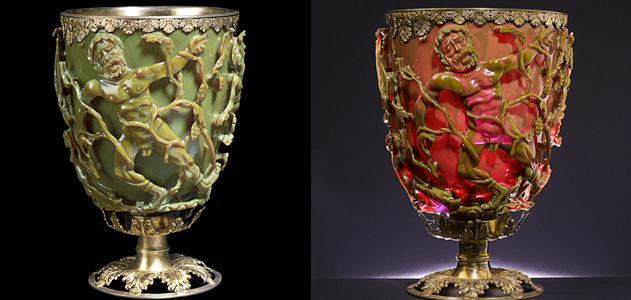By Koen Beumer
Nanotechnology is new. And yet discussions about nanotechnology feature numerous references to artifacts from ancient times. Nanotechnology is said to be present in anything from stained glass in Medieval European churches to blades of eighteenth century Indian warriors. How can we make sense of these historical references?
Nanotechnology (or: technology at the nano-scale) is often explained by pointing out that at the nano-scale, matter acquires new properties. These properties are said to enable the development of new products with new functions. This newness of nanotechnology can be considered to be one of the most important characteristics of the technology. After all, it is only because the technology can do something new, that it merits support and funding. And yet historical references pop up time and time again in discussions about nanotechnologies.
For instance, in discussions about nanotechnology in Europe, one can find references to stained glass in Medieval churches. Researchers recently discovered that these windows purify the air thanks to the presence of golden nanoparticles that break down toxic gasses (Wilson, 2008). Also the special properties of a late Roman glass goblet that is held by the British Museum have recently been connected to the presence of nano-particles. The drinking cup, depicting King Lycurgus of Trace, has a green color when lit from the front. But when held against the light, the glass suddenly changes color and turns red. This feature has long puzzled researchers but is now explained by the presence of golden and silver nanoparticles that alter the color of the glass depending on the position of the observer in relation to the light (e.g. see Freestone et al., 2007). These stories make clear that Europeans apparently have been long familiar with the special properties of materials at the nano-scale. The Romans, so one magazine concludes, were nanotechnology pioneers (Merali, 2013).

How can we make sense of these historical references in discussions about a technology whose public support predominantly depends on its newness?
A shift in geographical focus can provide some clarity about the function of such references. Let’s have a look at the Indian discussions about nanotechnology. Although references to European churches and Roman drinking cups can also be found in India, stories about ancient Indian artifacts that contain nanotechnology have circulated much more widely there. One can for instance find claims that 2,000 year-old paintings in the Ajanta caves in Maharashtra, near Mumbai, are an early example of nanotechnology (e.g. see PTI 2008; Sridhar, 2012) and also various Ayurvedic practices are associated with nanotechnology. One commentator even concludes that “bhasmas’ used in Ayurveda (…) is the oldest form of nanotechnology” (TNN 2009).
As in the European examples, the special properties of these phenomena are retrospectively credited to the use of nanotechnology, often in a tone that mixes pride and irony. The stories do not suggest that their ancestors actually knew what nanotechnology was – the term nanotechnology itself only dates from 1974. But the stories do claim that nanotechnology has been present in India for at least a couple of hundred years. While supporters and critics alike assert that nanotechnology is new in almost every way, these stories also suggest that India is already well-acquainted with the technology. Just like in Europe, where the origins of nanotechnology are traced to the Romans, in India people from their own continent appear as nanotechnology pioneers – a form of Whig history in the public discussion on new technologies.

Such historical references can be understood as a way to assert ownership over new technologies. Although certainly also true in the case of ‘Western’ countries, this is particularly well-visible in postcolonial settings. In the case of India, historians of science and technology have earlier observed the ideological need for the local and the indigenous, noting that “modern technology, especially in the post-colony, was always marked with the trace of the foreign. Yet true independence required self-reliance and indigeneity, especially in relation to technology” (Abrahams, 2006). Indeed the Indian discourse on nanotechnology can be found to have a strong emphasis on international competition, casting nanotechnology as the subject of a global race (Beumer & Bhattacharya, 2013). In this context, connections between nanotechnology and older Indian technologies strengthen the impression that nanotechnology has already taken root in India and that India is well-positioned to participate in the nanotechnology race.
Perhaps this is nowhere clearer than in references made to the sword of Tipu Sultan. Sultan was an eighteenth century king of Mysore, in southern India, whose sword was famous for its strength. As with the other examples, the strength of the sword is now explained by the presence of nanotechnology. The significance of this example, however, goes further, for Tipu Sultan is particularly well-known in India for successfully standing up to the British colonizers. In two successive wars he managed to defeat the British army (though eventually being killed in a fourth encounter with the British East India Company in 1799). Not only has India been long-acquainted with this new technology, so the suggestion goes, the use of nanotechnology can even serve India well in the face of foreign competition.
These historical references can be well-understood by situating them in the wider context of technology-society relations. And reversely, even for the newest technologies, such Whiggish historical references can provide interesting clues for understanding the relation between technology and society.
o-o-o
Koen Beumer is a PhD candidate at the Department of Technology and Society Studies at Maastricht University. For his research he investigates the governance of nanotechnology in India, South Africa, and Kenya.

